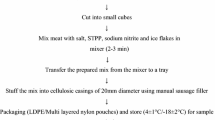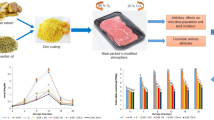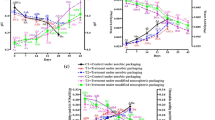Abstract
Purpose
Meat byproduct is rich source protein for hydrolysis. Pork liver is low value byproduct obtained from meat industry. Therefore, utilization of low value slaughterhouse byproduct enhances the income of meat industry, reduces the cost of disposal and environmental pollution.
Methods
Physico-chemicals, colour profiles, lipid oxidation, the antioxidant and antimicrobial potential of liver hydrolysate (at three levels T1 = 0.03, T2 = 0.06 and T3 = 0.09% w/w meat emulsion) were comparatively investigated with control (without hydrolysate C = 0) and positive control (PC (BHT = 0.02% w/w meat emulsion)) in meat emulsion. Samples were stored at 4 ± 1 °C under aerobic packaging condition and were drawn at 2 days intervals for analysis.
Results
Results revealed that pH values increased significantly (P < 0.05) however, water activity, extract release volume and emulsion stability decreased significantly thought storage. The sample having a higher concentration of hydrolysate significantly (P < 0.05) showed higher antioxidant activity except BHT treated sample. Comparatively lower lipid oxidation and coloure profile deterioration were recorded in PC and T3 than other groups. Meat emulsion prepared with the addition of 0.09% liver hydrolysate exhibited significantly (P < 0.05) higher antimicrobial activities (SPC, Coliforms and, Yeast and mould) than another sample during storage. Meat emulsion treated with hydrolysate also examined for the microbial challenge test for Listeria monocytogenes, Staphylococcus aureus, E. coli, and Bacillus cereus microbes showed comparatively lower microbial proliferation than control during refrigerated storage.
Conclusion
Therefore, liver protein hydrolysate maybe used as natural preservatives having improved antioxidant and antimicrobial activities for the shelf-life enhancement of meat products.
Graphic Abstract




Similar content being viewed by others
References
Guo, H., Kouzuma, Y., Yonekura, M.: Structures and properties of antioxidative peptides derived from royal jelly protein. Food Chem. 113, 238–245 (2009)
Bougatef, H., Krichen, F., Kobbi, S., Martinez-Alvarez, O., Nedjar, N., Bougatef, A., Sila, A.: Physicochemical and biological properties of eel by-products protein hydrolysates: potential application to meat product preservation. Waste Biomass Valoriz. 11(3), 931–942 (2020)
Je, J.Y., Lee, K.H., Lee, M.H., Ahn, C.B.: Antioxidant and antihypertensive protein hydrolysates produced from tuna liver by enzymatic hydrolysis. Food Res. Int. 42, 1266–1272 (2009)
López-Pedrouso, M., Borrajo, P., Pateiro, M., Lorenzo, J.M., Franco, D.: Antioxidant activity and peptidomic analysis of porcine liver hydrolysates using alcalase, bromelain, flavourzyme and papain enzymes. Food Res. Int. 137, 109389 (2020)
Verma, A.K., Chatli, M.K., Kumar, P., Mehta, N.: In-vitro assessment of antioxidant and antimicrobial activity of whole porcine-liver hydrolysates and its fractions. Anim. Prod. Sci. 59, 641–646 (2019)
Verma, A.K., Chatli, M.K., Mehta, N., Kumar, P.: Assessment of physico-chemical, antioxidant and antimicrobial activity of porcine blood protein hydrolysate in pork emulsion stored under aerobic packaging condition at 4±1 C. LWT-Food Sci. Technol. 88, 71–79 (2018)
Townsend, W.E., Witnauer, L.P., Riloff, J.A., Swift, C.E.: Comminuted meat emulsions. Differential thermal analysis of fat transition. Food Technol. 22, 319–323 (1968)
Jay, J.M.: Beef microbial quality determined by extract release volume (ERV). Food Technol. 18, 1637–1641 (1964)
Brand-Williams, W., Cuvelier, M.E., Berset, C.: Use of a free radical method to evaluate antioxidant activity. LWT Food Sci. Technol. 28, 25–30 (1995)
Salami, M., Yousefi, R., Ehsani, M.R., Razavi, S.H., Chobert, J.M., Haertle, T.: Enzymatic digestion and antioxidant activity of the native and molten globule states of camel α-lactalbumin: possible significance for use in infant formula. Int. Dairy J. 19, 518–523 (2009)
Benzie, I.F.F., Strain, J.J.: Ferric reducing/antioxidant power assay: direct measure of total antioxidant activity of biological fluids and modified version for simultaneous measurement of total antioxidant power and ascorbic acid concentration. Method Enzymol. 299, 15–27 (1999)
Kumar, A., Chattopadhyay, S.: DNA damage protecting activity and antioxidant potential of pudina extract. Food Chem. 100, 1377–1384 (2007)
Koniecko, R.: Handbook for Meat Chemists, pp. 53–55. Avery Publishing Group, Inc., Wayne, NJ (1979)
Witte, V.C., Krause, G.F., Bailey, M.E.: A new extraction method for determining 2-Thiobarbituric acid values of pork beef during storage. J. Food Sci. 35, 582–585 (1970)
APHA: Compendium of Methods for Microbiological Examination of Foods, 2nd edn. American Public Health Association, Washington, DC (1984)
Abed, N.E., Kaabi, B., Smaali, M.I., Chabbouh, M., Habibi, K., Mejri, M., Marzouki, M.N., Ahmed, S.B.H.: Chemical composition, antioxidant and antimicrobial activities of Thymus capitata essential oil with its preservative effect against Listeria monocytogenes inoculated in minced beef meat. Evid. Based Complement. Altern. Med. (2014). https://doi.org/10.1155/2014/152487
Jaye, M., Kittaka, R.S., Ordal, Z.J.: The effect of temperature and packaging material on the storage life and bacterial flora of ground beef. Food Technol. 16, 95–98 (1962)
Aksu, M.I., Kaya, M.: Effect of storage temperatures and time on shelf-life of sliced and modified atmosphere packaged Pastırma, a dried meat product, produced from beef. J. Sci. Food Agric. 85(8), 1305–1312 (2005)
Kim, H., Chin, K.B.: Evaluation of antioxidant activity of Cudrania tricuspidata (CT) leaves, fruit powder and ct fruit in pork patties during storage. Food Sci. Anim. Resour. 40, 881 (2020)
Jay, J.M., Loessner, J.M., Golden, D.A.: Modern Food Microbiology, 7th edn., pp. 101–118. Springer, New York (2005)
Murthy, T.R.K., Bachhil, V.N.: Influence of pH on hydration during spoilage of pork at refrigeration temperature. J. Food Sci. Technol. 17, 201–202 (1980)
Ingram, M., Dainty, R.H.: Changes caused by microbes in spoilage of meats. J. Appl. Microbiol. 34(1), 21–39 (1971)
Pearson, D.: Assessing beef acceptability. Food Manuf. 42, 42–47 (1967)
Anandh, M.A.: Shelf life of boiled restructured buffalo meat rolls in refrigerated storage under vacuum packaging condition. J. Appl. Anim. Res. 43, 318–323 (2015)
Verma, A.K., Chatli, M.K., Kumar, P., Mehta, N.: Antioxidant and antimicrobial activity of porcine liver hydrolysate in meat emulsion and their influence on physico-chemical and color deterioration during refrigeration storage. J. Food Sci. 84, 1844–1853 (2019)
Xie, Z.J., Huang, J.R., Xu, X.M., Jin, Z.Y.: Antioxidant activity of peptides isolated from alfalfa leaf protein hydrolysate. Food Chem. 111, 370–376 (2008)
Davies, M.J.: The oxidative environment and protein damage. BBA-Proteins Proteom. 1703, 93–109 (2005)
Balakrishnan, B., Prasad, B., Rai, A.K., Velappan, S.P., Subbanna, N.M., Narayan, B.: In vitro antioxidant and antibacterial properties of hydrolysed proteins of delimed tannery fleshings: comparison of acid hydrolysis and fermentation methods. Biodegradation 22, 287–295 (2011)
Sakanaka, S., Tachibana, Y.: Active oxygen scavenging activity of egg-yolk protein hydrolysates and their effects on lipid oxidation in beef and tuna homogenates. Food Chem. 95, 243–249 (2006)
Verma, A.K., Chatli, M.K., Kumar, P., Mehta, N.: Effects of inclusion of porcine blood hydrolysate on physico-chemical quality, oxidative and microbial stability of pork batter stored at (4±1 °C). J. Food Sci. Technol. 55, 4758–4769 (2018)
Onuh, J.O., Girgih, A.T., Aluko, R.E., Aliani, M.: In vitro antioxidant properties of chicken skin enzymatic protein hydrolysates and membrane fractions. Food chem. 150, 366–373 (2014)
Young, K.M., Cramp, R.L., Franklin, C.E.: Each to their own: skeletal muscles of different function use different biochemical strategies during aestivation at high temperature. J. Exp. Biol. 216, 1012–1018 (2013)
Kawashima, K., Itoh, H., Miyoshi, M., Chibata, I.: Antioxidant properties of branched-chain amino acid derivatives. Chem. Pharm. Bull. 27, 1912–1916 (1979)
Park, P.J., Jung, W.K., Nam, K.S., Shahidi, F., Kim, S.K.: Purification and characterization of antioxidative peptides from protein hydrolysate of lecithinfree egg yolk. J. Am. Oil Chem. Soc. 78, 651–656 (2001)
Wu, H.C., Chen, H.M., Shiau, C.Y.: Free amino acids and peptides as related to antioxidant properties in protein hydrolysates of mackerel (Scomber austriasicus). Food Res. Int. 36, 949–957 (2003)
Liu, Q., Kong, B., Xiong, Y.L., Xia, X.: Antioxidant activity and functional properties of porcine plasma protein hydrolysate as influenced by the degree of hydrolysis. Food Chem. 118, 403–410 (2010)
Farvin, K.H.S., Andersen, L.L., Nielsen, H.H., Jacobsen, C., Jakobsen, G., Johansson, I., Jessen, F.: Antioxidant activity of Cod (Gadus morhua) protein hydrolysates: In vitro assays and evaluation in 5% fish oil-in-water emulsion. Food Chem. 149, 326–334 (2014)
Hirose, A., Miyashita, K.: Inhibitory effect of proteins and their hydrolysates on the oxidation of triacylglycerols containing docosahexaenoic acids in emulsion. Nippon Shokuhin Kagaku Kogaku Kaishi 46, 799–805 (1999)
Dekkers, E., Raghavan, S., Kristinsson, H.G., Marshall, M.R.: Oxidative stability of mahimahi red muscle dipped in tilapia protein hydrolysates. Food Chem. 124, 640–645 (2011)
Jin, S.K., Choi, J.S., Choi, Y.J., Lee, S.J., Lee, S.Y., Hur, S.J.: Development of sausages containing mechanically deboned chicken meat hydrolysates. J. Food Sci. 80, S1563–S1567 (2015)
Barbut, S.: Effect of regular and hydrolysed dairy proteins on texture, microstructure and color of lean poultry meat batters. Int. J. Food Sci. Technol. 43, 1792–1797 (2008)
Tossi, A., Sandri, L., Giangaspero, A.: Amphipathic, alpha-helical antimicrobial peptides. Biopolymers 55, 4–30 (2000)
Lei, J., Sun, L., Huang, S., Zhu, C., Li, P., He, J., He, Q.: The antimicrobial peptides and their potential clinical applications. Am. J. Transl. Res. 11, 3919 (2019)
Daoud, R., Dubois, V., Bors-Dodita, L., Nedjar-Arroume, N., Krier, F., Chihib, N.-E.: New antibacterial peptide derived from bovine hemoglobin. Peptides 26, 713–719 (2005)
Liu, Z.Y., Dong, S.Y., Xu, J., Zeng, M.Y., Song, H.X., Zhao, Y.H.: Production of cysteine-rich antimicrobial peptide by digestion of oyster (Crassostreagigas) with alcalase and bromelin. Food Control 19, 231–235 (2008)
Wang, F.S.: Effect of antimicrobial proteins from porcine leukocytes on Staphylococcus aureus and Escherichia coli in comminuted meats. Meat Sci. 65, 615–621 (2003)
Demers-Mathieu, V., Gauthier, S.F., Britten, M., Fliss, I., Robitaille, G., Jean, J.: Inhibition of Listeria monocytogenes growth in Cheddar cheeseby an anionic peptides-enriched extract from whey proteins. Int. Dairy J. 32, 6–12 (2013)
Oses, S.M., Dieza, A.M., Gómeza, E.M., Wilches-Péreza, D., Luning, P.A., Jaimea, I., Rovira, J.: Control of Escherichia coli and Listeria monocytogenes in suckling-lamb meat evaluated using microbial challenge tests. Meat Sci. 110, 262–269 (2015)
Jin, S.K., Choi, J.S., Yim, D.G.: Hydrolysis Conditions of Porcine Blood Proteins and Antimicrobial Effects of Their Hydrolysates. Food Sci. Anim. Resour. 40, 172 (2020)
Acknowledgements
The 1st author of this research article acknowledges the DST-Inspire fellowship, Ministry of Science and Technology, Government of India.
Author information
Authors and Affiliations
Contributions
AKV and MKC have contributed equally in designing the research. AKV carried out the experiments, recorded data and prepared the manuscript. PK and NM helped in interpretation and analysis of the data.
Corresponding author
Ethics declarations
Conflict of interest
The authors declare that they have no conflict of interest.
Additional information
Publisher's Note
Springer Nature remains neutral with regard to jurisdictional claims in published maps and institutional affiliations.
Rights and permissions
About this article
Cite this article
Verma, A.K., Chatli, M.K., Mehta, N. et al. Antimicrobial and Antioxidant Potential of Papain Liver Hydrolysate in Meat Emulsion Model at Chilling Storage Under Aerobic Packaging Condition. Waste Biomass Valor 13, 417–429 (2022). https://doi.org/10.1007/s12649-021-01538-3
Received:
Accepted:
Published:
Issue Date:
DOI: https://doi.org/10.1007/s12649-021-01538-3




